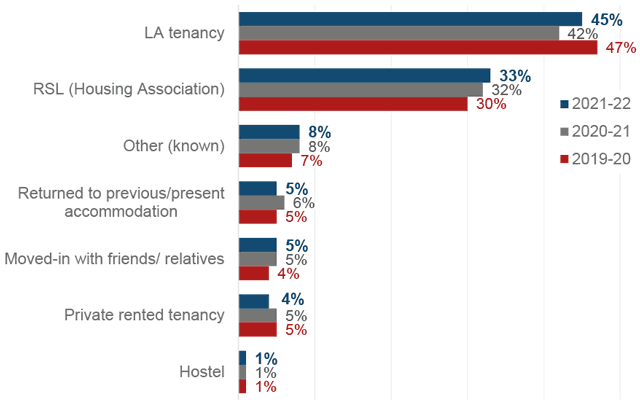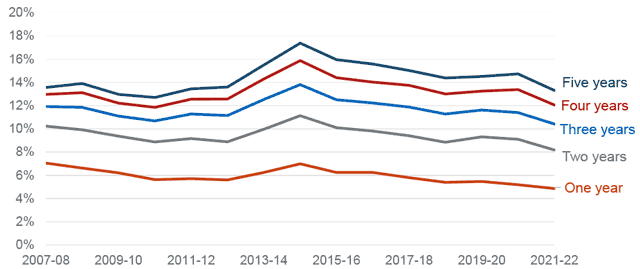Homelessness in Scotland: 2021/22
This statistics bulletin provides information on homelessness in Scotland in the period from 1 April 2021 to 31 March 2022, alongside historical data.
This document is part of a collection
Outcomes
Key Points in 2021/22
- 28,043 homelessness cases closed (unintentionally and intentionally homeless) - an increase of 5%
- 82% of unintentionally homeless households secured settled accommodation, increasing from 80% in 2020/21
- The proportions of households re-assessed as homeless are the lowest in the time series; 8% of applicants re-assessed in the previous two years compared to 9% in 2020/21 and 10% in 2007/08
Homelessness cases are closed once the local authority has fulfilled its statutory duty or contact has been lost with the applicant household for 28 days. Local authorities provide information on the circumstances and outcomes of homelessness cases once they have been closed.
Number of cases closed
Overall, 28,043 cases were closed in 2021/22, an increase of 5% compared to 2020/21.
There were 6% more homelessness cases closed in 2021/22 for applications assessed as unintentionally homeless or threatened with homelessness (27,679 compared to 26,167 in 2020/21). The number of cases closed declined following the outbreak of COVID-19. They have now started to increase but are yet to reach pre-pandemic levels (28,586 in 2019/20).
There were 37% fewer intentionally homelessness cases closed (from 580 to 364). This, again, is a result of the changes in intentionality legilsation as noted previously.
How often do local authorities lose contact with applicants?
For households assessed in 2021/22, contact was maintained for 93% of those assessed as unintentionally homeless and for 88% assessed as intentionally homeless.
The proportion of households maintaining contact has increased over time for unintentionally homeless households, from 81% in 2007/08. For intentionally homeless households, the proportion has remained more stable, particularly in recent years (between 85 and 88% since 2013/14).
What are the outcomes for homeless households?
Of the 25,816 unintentionally homelessness cases that closed in 2021/22 (where contact was maintained and the outcome was known), 82% (20,686) secured settled accommodation.
There is a larger proportion of households settled into local authority tenancies - returning towards pre-pandemic proportions

Settled accommodation is defined as a local authority tenancy, a tenancy with a registered social landlord or a private rented tenancy.
The proportion of unintentionally homeless households securing settled accommodation has increased over time, from 64% in 2002/03 to 83% in 2015/16 and 2019/20.
Intentionally homeless households are less likely to secure settled accommodation. However, the proportion increased from 45% in 2020/21 to 52% in 2021/22. To note, these are based on relatively small numbers (which have decreased as a result of changes in intentionality legislation), and are therefore particularly susceptible to natural fluctuation.
Is there a return to homelessness?
In order to understand the longer-term outcomes for homeless households, and whether outcomes upon case closure are sustained, there is interest in ‘repeat homelessness’. This is defined as households previously assessed as homeless re-entering the homelessness system at a later point in time.
Households re-assessed as homeless as a proportion of all homeless households have shown a decreasing trend since 2014/15

There were 1,404 households (5%) that had previously been assessed as homeless in the 12 months prior to their most recent assessments, and 3,844 households (13%) in the previous 5 years. Note that these are cumulative.
There is significant local variation between local authorities with respect to repeat homelessness. For example, 9% of homeless households in Glasgow and Inverclyde had previously been assessed as homeless in the 12 months prior to their assessment. This is compared to 0% in Orkney, Shetland and East Dunbartonshire, though these are based on relatively small numbers.
Were housing support assessments carried out?
Upon closing a homelessness case, local authorities are required to assess whether any housing support services are required by the household for any cases assessed as unintentionally homeless and where it has reason to believe that support would be beneficial. It also has a duty to provide that support if needed.
Across Scotland, assessments for housing support needs were carried out in 82% of cases where there was a duty to assess in 2021/22. In 18% of cases where there was a duty to assess, no assessment took place and no support was provided. Housing support was provided in 43% of all cases. Support was not provided for 6% of cases where a support need was identified.
Contact
There is a problem
Thanks for your feedback